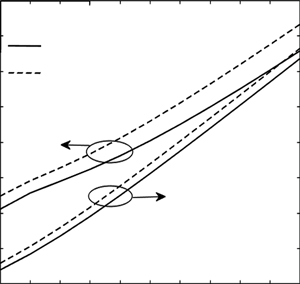Channel capacity analysis of various adaptive transmission schemes and BER performance at Beaulieu-Xie fading
DOI:
https://doi.org/10.3103/S0735272722010034Keywords:
Adaptive transmission, Bit error rate, Channel capacity, probability density function, Beaulieu-Xie fading model.Abstract
Optimization of spectral efficiency and quality of service can attain functional channel capacity for a wireless communication system. The channel capacity analysis over a fading channel is essential for realizing this goal. A recently developed model called Beaulieu–Xie fading channel model acquires the flavors of flexibility from Nakagami-m fading parameters and the non-centralized chi-distribution of the Rician fading model, which characterizes both line of sight and non-line of sight channels. The current work presents the channel capacity analysis with adaptive transmission techniques over Beaulieu–Xie fading channels. Various adaptive transmission schemes, such as channel inversion with a fixed-rate, truncated channel inversion with a fixed-rate, and optimal rate adaptation, are evaluated for the Beaulieu–Xie fading channel model. Additionally, the performance of the wireless system in terms of the bit error rate of coherent and non-coherent modulation is derived mathematically for this fading channel. Lastly, the mathematical expressions derived are verified with the help of Monte–Carlo simulation or standard results available in the literature.
References
- M. K. Simon, M.-S. Alouini, Digital Communication over Fading Channels. New York: Wiley-IEEE Press, 2004.
- J. Proakis, M. Salehi, Digital Communications, 5th ed. New York: McGraw-Hill Science/Engineering/Math, 2007, uri: http://www.amazon.com/Digital-Communications-Edition-John-Proakis/dp/0072957166.
- M. Nakagami, “The m-distribution—a general formula of intensity distribution of rapid fading,” in Statistical Methods in Radio Wave Propagation, Elsevier, 1960, pp. 3–36.
- N. C. Beaulieu, X. Jiandong, “A novel fading model for channels with multiple dominant specular components,” IEEE Wirel. Commun. Lett., vol. 4, no. 1, pp. 54–57, 2015, doi: https://doi.org/10.1109/LWC.2014.2367501.
- P. S. Chauhan, S. Kumar, S. K. Soni, “On the physical layer security over Beaulieu-Xie fading channel,” AEU - Int. J. Electron. Commun., vol. 113, no. 0, p. 152940, 2020, doi: https://doi.org/10.1016/j.aeue.2019.152940.
- A. Olutayo, H. Ma, J. Cheng, J. F. Holzman, “Level crossing rate and average fade duration for the Beaulieu-Xie fading model,” IEEE Wirel. Commun. Lett., vol. 6, no. 3, pp. 326–329, 2017, doi: https://doi.org/10.1109/LWC.2017.2685506.
- V. Kansal, S. Singh, “Analysis of effective capacity over Beaulieu-Xie fading model,” in 2017 IEEE International WIE Conference on Electrical and Computer Engineering (WIECON-ECE), 2017, pp. 207–210, doi: https://doi.org/10.1109/WIECON-ECE.2017.8468917.
- V. Kansal, S. Singh, “Analysis of average symbol error probability of MDPSK, MFSK and MPSK in the Beaulieu-Xie fading,” in 2018 6th Edition of International Conference on Wireless Networks & Embedded Systems (WECON), 2018, pp. 11–14, doi: https://doi.org/10.1109/WECON.2018.8782053.
- M.-S. Alouini, A. J. Goldsmith, “Capacity of Rayleigh fading channels under different adaptive transmission and diversity-combining techniques,” IEEE Trans. Veh. Technol., vol. 48, no. 4, pp. 1165–1181, 1999, doi: https://doi.org/10.1109/25.775366.
- M. D. Laishram, D. S. Aheibam, “Performance of dual-branch selection combining receiver over Fluctuating Two-Ray (FTR) fading channels for 5G mmWave communications,” AEU - Int. J. Electron. Commun., vol. 117, no. 0, p. 153093, 2020, doi: https://doi.org/10.1016/j.aeue.2020.153093.
- A. D. Singh, R. Subadar, “Capacity analysis of M-SC receivers over TWDP fading channels,” AEU - Int. J. Electron. Commun., vol. 68, no. 2, pp. 166–171, 2014, doi: https://doi.org/10.1016/j.aeue.2013.08.001.
- H. Zhao, Z. Liu, M.-S. Alouini, “Different power adaption methods on fluctuating two-ray fading channels,” IEEE Wirel. Commun. Lett., vol. 8, no. 2, pp. 592–595, 2019, doi: https://doi.org/10.1109/LWC.2018.2881158.
- R. Subadar, A. D. Singh, “Performance of M-MRC receivers over TWDP fading channels,” AEU - Int. J. Electron. Commun., vol. 68, no. 6, pp. 569–572, 2014, doi: https://doi.org/10.1016/j.aeue.2014.01.003.
- V. A. Aalo, “Performance of maximal-ratio diversity systems in a correlated Nakagami-fading environment,” IEEE Trans. Commun., vol. 43, no. 8, pp. 2360–2369, 1995, doi: https://doi.org/10.1109/26.403769.
- M. Olyaee, M. Eslami, J. Haghighat, “Performance of maximum ratio combining of fluctuating two‐ray (FTR) mmWave channels for 5G and beyond communications,” Trans. Emerg. Telecommun. Technol., vol. 30, no. 10, p. 0, 2019, doi: https://doi.org/10.1002/ett.3601.
- V. Kansal, S. Singh, “Capacity analysis of maximal ratio combining over Beaulieu-Xie fading,” Ann. Telecommun., vol. 76, no. 1–2, pp. 43–50, 2021, doi: https://doi.org/10.1007/s12243-020-00762-7.
- I. S. Gradshteyn, I. M. Ryzhik, Tables of Integrals, Series and Products. Academic Press, 2015.
- S. Janarthanan, V. Bhaskar, “Capacity analysis of Rayleigh fading channels in low signal‐to‐noise ratio regime for maximal ratio combining diversity because of combining errors,” IET Commun., vol. 7, no. 8, pp. 745–754, 2013, doi: https://doi.org/10.1049/iet-com.2012.0647.
- A. Sharma, V. K. Dwivedi, G. Singh, “Channel capacity with suboptimal adaptation technique over generalized-K fading using marginal moment generating function,” Radioelectron. Commun. Syst., vol. 59, no. 8, pp. 325–334, 2016, doi: https://doi.org/10.3103/S073527271608001X.


